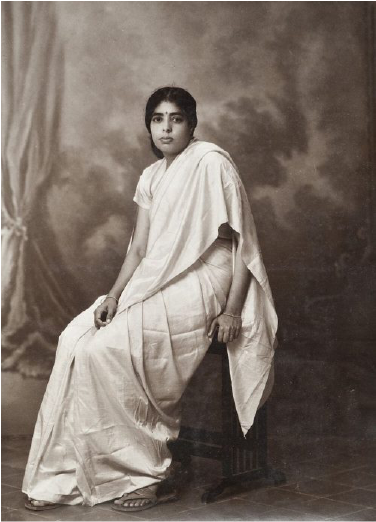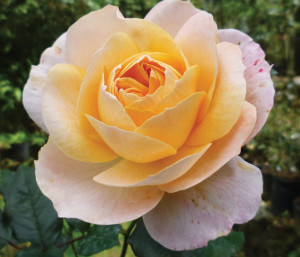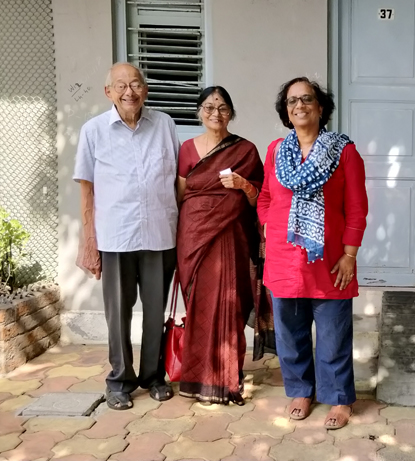Registered with the Registrar of Newspapers for India under R.N.I 53640/91
Vol. XXIX No. 5, June 16-30, 2019
A pioneer botanist – a path-breaker in horticulture
by Girija and M.S.Viraraghavan

E.K. Janaki Ammal.
Many of you may not have heard of the scientist E.K. Janaki Ammal. But if you are a plant breeder interested in the genetics of plants, their chromosome numbers and their ploidy (the number of complete sets of chromosomes in a cell – diploid refers to 2 sets of chromosomes, triploid, 3 and so on) in order to make meaningful crosses, you will certainly recognise her name. E.K. Janaki Ammal, along with C.D. Darlington, is the author of Chromosome Atlas of All Cultivated Plants, a Bible among plant scientists. She dedicated her life to the study of countless plant species, solving their genetic codes. Her work is widely considered to be a seminal contribution to the field of Botany and she was awarded the Padma Shri in 1977.
Born in 1897 in Thalaserry, Kerala, E.K. Janaki Ammal was a brilliant cytogeneticist who battled great odds to achieve outstanding success in her field – she was an Indian woman of mixed heritage belonging to the so called ‘low’ caste of Ezhavas of Kerala and had an English grandfather who was a judge in British India.
Her judge father encouraged her to study and she made him proud – she acquired first a Bachelor’s and then a Master’s degree in Botany from Presidency College Madras in 1921, followed by a Barbour scholarship for another Master’s degree at the University of Michigan USA in 1925. In 1931, Michigan University conferred on her an honorary doctorate (DSc. Honoris Causa) – to this day, she remains one of the very few Asian women to have had this honour.
Janaki Ammal chose a life of scholarship over marriage, unheard of in those times. She taught in Chennai and Trivandrum for some years before being chosen by Nobel laureate Sir C.V. Raman as a Research Fellow to study sugarcane in the newly established Indian Academy of Sciences. She made path-breaking strides at the Academy by developing hybrid sugarcane varieties that were not only well-suited to Indian climes but that also produced sweeter sugar.
But prevailing gender and caste discrimination disgusted her, and she left for England to join the famous John Innes Institute in Norwich as a cytologist. She worked there between 1940 and 1945, braving wartime bombings on a daily basis – she would dive under the beds during raids and report to work in the morning, sweeping broken glass and debris in the office. Impressed by her tenacity, the Royal Horticultural Society invited her to join them in their gardens at Wisley near Kew. It was here that she met many world famous plant scientists, including the biologist Dr. C.D. Darlington, who would became her friend, mentor and later, co-author. At Wisley, she worked on the plant magnolia and planted many in the gardens. They still flower today, including one named after her – Magnolia Kobus ‘Janaki Ammal’.
Serendipitously, on a flight home to India in 1948, she met the then Prime Minister Pandit Jawaharlal Nehru. He was so impressed by her that he invited her to return and head the newly-formed Botanical Survey of India (BSI). She agreed and reorganised the office in Calcutta in the 1950s. Her interest in biodiversity and ecology took her to remote parts of the country. She collected numerous indigenous plants, many of medicinal value, as well as folklore and tribal knowledge systems, incorporating them into the work of the BSI.
An environmentalist, she actively protested against harmful dams and hydroelectric projects, such as the Silent Valley in Kerala. She worked at the Atomic Energy Station in Trombay and lectured at international symposiums. Post-retirement, she became Emeritus Scientist in the Centre for Advanced Botany in the Madras University at Maduravoyal, Chennai.
Janaki Ammal led an ascetic life, focused entirely on her work. She died in 1984 at age 87. In recognition of her peerless contributions to Botany, the Government of India has instituted scholarships in her name. The John Innes Institute in the UK also offers aid for students from developing countries under its E.K. Janaki Ammal Scholarship program.
A rose for E.K. Janaki Ammal

‘E.K. Janaki Ammal’ – the rose developed by Girija and Viraraghavan in Kodaikanal, in honour of a pioneering scientist.
In May 1966, Viru & I bought a copy of her seminal work, the ‘Chromosome Atlas of Cultivated Plants’, when Viru was attempting rose breeding for the first time. He had wanted to focus on rose species native to India, and the book was essential reading to understand the ploidy of different rose species. Viru continues to refer to Janaki Ammal’s book even today, as he breeds other plants like rhododendrons, magnolias and the Himalayan blue poppy (meconopsis). We’ve had to rebind the book as the pages were coming apart with frequent use!
We were eager to know more about Janaki Ammal. Her astonishing and remarkable story left us wonderstruck and we wished we had known her before she died in 1984. She had no immediate family as she was unmarried, but she did have many nieces and nephews. Little of her papers and personal effects remain, but fortunately, many of her academic papers are still available at the Bodleian Library in Oxford.
We strongly felt that this remarkable woman scientist had not been given the recognition she deserved – after all, her groundbreaking work continues to be referenced by scientists all over the world today. We decided to honour her by naming a rose after her, like we had done in the past for Sir George Watt, Sir Henry Collett and Frank Kingdon Ward (all of whom discovered Rosa Gigantea in the wild), Leschenault de la Tour (who discovered R. Leschenaultiana, a rose native to the Western Ghats) and other dear friends across the world.
We first needed to get in touch with a relation of Janaki Ammal, to request permission. We had help from our good friend Dr. Henry Noltie of the Royal Botanic Gardens in Edinburgh. He is a confirmed Indophile specialising in the histories of British Indian botanists – he has written the biographies of Robert Wight (the East India Company surgeon who was more of a botanist in the 1800’s), and Hugh Cleghorn ( India’s first Inspector General of Forests). Dr. Henry directed us to Dr Vinita Damodaran, Janaki Ammal’s great niece, currently the Head of the Department of South Asian History in the University of Sussex, U.K.
Henry knew Dr. Vinita well. He had accompanied her on a visit to the Botanical Survey of India, in 2016, helping her set up the Kew exhibition on the botanical explorations conducted by Joseph Dalton Hooker in India. She in turn helped set up a new gallery on Botanical History, showcasing the sketches, research activities, letters, photographs etc of Janaki Ammal, ‘a pioneer woman botanist of the country who laid a base-line of botanical research of BSI’. This exhibition is active even today – when we attended the January 2017 Kolkata National Rose Convention, we took time off to visit the lovely, old high-ceilinged BSI Headquarters on Sudder Street and spent time with Janaki Ammal. The museum is beautifully preserved and well worth a visit. An entire floor of the building displayed the exhibition on Janaki Ammal, with many photographs, facsimiles of her correspondence and her work papers. What an extraordinary woman she was!
 From left to right: M.S. Viraraghavan and Girija Viraraghavan with Dr. Vinita Damodaran in Pondicherry.
From left to right: M.S. Viraraghavan and Girija Viraraghavan with Dr. Vinita Damodaran in Pondicherry.We wrote to Dr. Vinita, explaining that we had a Rosa clinophylla seedling which we had tested for many years, and which flowered well and continuously, and could we have her permission to name this rose for her great aunt? We also wrote that the rose was a medium-dark, rich yellow hue, which we thought was a befitting tribute to Janaki who reportedly wore saris only of this colour. Pat came her reply: she was delighted that Janaki Ammal was being recognised in this manner. The hybrid is a true-blue Indian signature species and we’re naming it ‘E.K Janaki Ammal’.
For those interested, the parentage of this rose is: Landora x [Montezuma x {Little Darling x ( R.clinophylla x R.bracteata)}] It has been classified as a Grandiflora, yellow blend color, fragrant, a tall growing shrub, disease resistant and continuous flowering. We have shared the material of this rose with the Botanical Survey of India, John Innes Institute and the Royal Horticultural Society so that they can flower in their gardens as a perennial tribute to Janaki Ammal’s work.


Comments